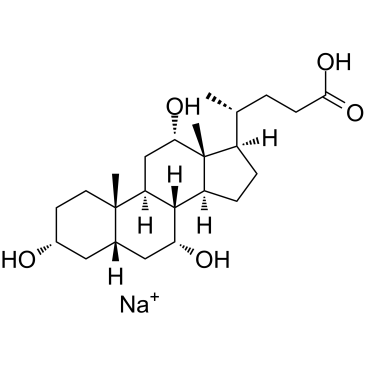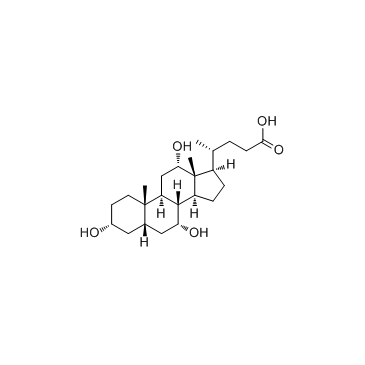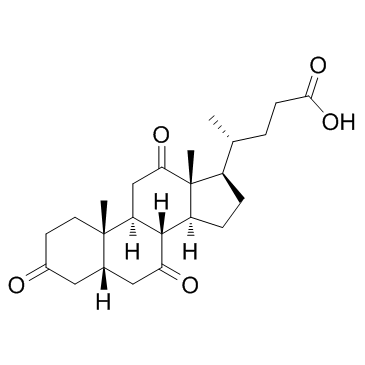361-09-1
| 中文名 | 胆酸钠 |
|---|---|
| 英文名 | sodium cholate |
| 中文别名 |
3α,7α,12α-三羟基-5β-胆烷酸单钠盐
牛羊胆酸 胆汁酸 |
| 英文别名 |
colalin
cholic acid sodium cholsaeure sodium salt of cholic acid Cholic acid,sodium salt EINECS 206-643-5 7,12-Triol Cholic acid CHOLALIC ACID SodiumCholate CHOLIC ACID NA-SALT 3α,7α,12α-Trihydroxy-5β-cholan-24-oic acid sodium salt,Cholalic acid sodium salt deoxycholic acid sodium salt MFCD00064138 SODIUMCHOLATE,REAGENT SODIUM CHOLEATE Sodium cholate CHOLIC ACID SODIUM SALT |
| 描述 | Cholic acid sodium 是肝脏中产生的主要胆汁酸,通常与甘氨酸或牛磺酸缀合,有助于脂肪吸收和胆固醇排泄。 |
|---|---|
| 相关类别 | |
| 体外研究 | 胆酸竞争性地结合HepG2细胞上的Na + /牛磺胆酸盐共转运多肽(NTCP),并显着抑制胆酸(CA)-纳米脂质体(LPs)-多柔比星(DOX)-HCl的摄取,这表明CA-LPs-DOX-HCl也通过NTCP介导的内吞途径摄取[1]。 |
| 细胞实验 | 用抑制剂NaN3(1mg/mL)、染料木黄酮(50μg/mL)、MβCD(10mM)、制霉菌素(50μg/mL)、氯丙嗪(10μg/mL)和胆酸(1mg/mL)预处理HepG2细胞30分钟,除去抑制剂后,与CA-LPs孵育2小时,LPs的细胞摄取在“体外细胞摄取测定”部分[1]中确定。 |
| 参考文献 |
| 沸点 | 583.9ºC at 760 mmHg |
|---|---|
| 熔点 | 198ºC |
| 分子式 | C24H40NaO5 |
| 分子量 | 430.553 |
| 闪点 | 321ºC |
| 精确质量 | 430.269531 |
| PSA | 100.82000 |
| LogP | 2.11400 |
| 外观性状 | 白色晶体 |
| 折射率 | 35 ° (C=0.6, EtOH) |
| 储存条件 | 棕色玻璃瓶密封包装。低温下存放。 |
| 稳定性 | 1.胆酸一水合物为白色片状结晶。无水物熔点198℃。15℃溶解度(g/L):水0.28;醇30.56;醚1.22;氯仿5.08;苯0.36;丙酮28.24;冰醋酸152.12,也溶于碱溶液。味先苦后甜,遇毛地黄皂苷不产生沉淀。 |
| 水溶解性 | 150 g/L (20 ºC) |
| 更多 | 性状:本品为白色粉末,无臭,味苦。 密度(g/mL,25/4℃):不可用 相对蒸汽密度(g/mL,空气=1):不可用 熔点(ºC):197-202 沸点(ºC,常压):不可用 沸点(ºC,5.2kPa):不可用 折射率:不可用 闪点(ºC):不可用 比旋光度(º):不可用 自燃点或引燃温度(ºC):不可用 蒸气压(kPa,25ºC):不可用 饱和蒸气压(kPa,60ºC):不可用 燃烧热(KJ/mol):不可用 临界温度(ºC):不可用 临界压力(KPa):不可用 油水(辛醇/水)分配系数的对数值:不可用 爆炸上限(%,V/V):不可用 爆炸下限(%,V/V):不可用 溶解性:其碱金属盐均易溶于水和醇中。 |
Synonym:Sodium cholate; 3alpha,7alpha,12alpha-Trihydroxy-5-cholanic acid sodium salt; Cholic acid, monosodium salt, sodium cholic acid; Cholan-24-oic acid, 3,7,12-trihydroxy-, monosodium salt, (3-alpha,5-beta,7-alpha; Cholic acid, monosodium salt; D Section 2 - COMPOSITION, INFORMATION ON INGREDIENTS
Risk Phrases: None Listed. Section 3 - HAZARDS IDENTIFICATION EMERGENCY OVERVIEW
Hygroscopic (absorbs moisture from the air).The toxicological properties of this material have not been fully investigated. Potential Health Effects Eye: May cause eye irritation. Skin: May cause skin irritation. Ingestion: May cause irritation of the digestive tract. Inhalation: May cause respiratory tract irritation. May cause effects similar to those described for ingestion. Chronic: No information found. Section 4 - FIRST AID MEASURES Eyes: Immediately flush eyes with plenty of water for at least 15 minutes, occasionally lifting the upper and lower eyelids. Get medical aid immediately. Skin: Get medical aid. Get medical aid immediately. Flush skin with plenty of water for at least 15 minutes while removing contaminated clothing and shoes. Wash clothing before reuse. Ingestion: Never give anything by mouth to an unconscious person. Get medical aid immediately. Do NOT induce vomiting. If conscious and alert, rinse mouth and drink 2-4 cupfuls of milk or water. Inhalation: Get medical aid immediately. Remove from exposure and move to fresh air immediately. If not breathing, give artificial respiration. If breathing is difficult, give oxygen. Notes to Physician: Section 5 - FIRE FIGHTING MEASURES General Information: As in any fire, wear a self-contained breathing apparatus in pressure-demand, MSHA/NIOSH (approved or equivalent), and full protective gear. During a fire, irritating and highly toxic gases may be generated by thermal decomposition or combustion. Extinguishing Media: Use water spray, dry chemical, carbon dioxide, or appropriate foam. Section 6 - ACCIDENTAL RELEASE MEASURES General Information: Use proper personal protective equipment as indicated in Section 8. Spills/Leaks: Sweep up, then place into a suitable container for disposal. Avoid generating dusty conditions. Provide ventilation. Section 7 - HANDLING and STORAGE Handling: Wash thoroughly after handling. Remove contaminated clothing and wash before reuse. Use with adequate ventilation. Avoid contact with eyes, skin, and clothing. Keep container tightly closed. Avoid ingestion and inhalation. Storage: Store in a tightly closed container. Store in a cool, dry, well-ventilated area away from incompatible substances. Store protected from moisture. Section 8 - EXPOSURE CONTROLS, PERSONAL PROTECTION Engineering Controls: Facilities storing or utilizing this material should be equipped with an eyewash facility and a safety shower. Use adequate ventilation to keep airborne concentrations low. Exposure Limits CAS# 361-09-1: Personal Protective Equipment Eyes: Wear appropriate protective eyeglasses or chemical safety goggles as described by OSHA's eye and face protection regulations in 29 CFR 1910.133 or European Standard EN166. Skin: Wear appropriate protective gloves to prevent skin exposure. Clothing: Wear appropriate protective clothing to prevent skin exposure. Respirators: A respiratory protection program that meets OSHA's 29 CFR 1910.134 and ANSI Z88.2 requirements or European Standard EN 149 must be followed whenever workplace conditions warrant respirator use. Section 9 - PHYSICAL AND CHEMICAL PROPERTIES Physical State: Crystals Color: white Odor: none reported pH: Not available. Vapor Pressure: Not available. Viscosity: Not available. Boiling Point: Not available. Freezing/Melting Point: 198 deg C Autoignition Temperature: Not applicable. Flash Point: Not applicable. Explosion Limits, lower: Not available. Explosion Limits, upper: Not available. Decomposition Temperature: Not available. Solubility in water: Soluble. Specific Gravity/Density: Not available. Molecular Formula: C24H39NaO5 Molecular Weight: 430.55 Section 10 - STABILITY AND REACTIVITY Chemical Stability: Stable under normal temperatures and pressures. Conditions to Avoid: Incompatible materials, strong oxidants, exposure to moist air or water. Incompatibilities with Other Materials: Oxidizing agents, moisture. Hazardous Decomposition Products: Acrid smoke and fumes. Hazardous Polymerization: Has not been reported. Section 11 - TOXICOLOGICAL INFORMATION RTECS#: CAS# 361-09-1: FZ9600000 LD50/LC50: CAS# 361-09-1: Oral, mouse: LD50 = 2400 mg/kg. Carcinogenicity: Cholic acid sodium salt - Not listed by ACGIH, IARC, or NTP. Other: See actual entry in RTECS for complete information. Section 12 - ECOLOGICAL INFORMATION Section 13 - DISPOSAL CONSIDERATIONS Dispose of in a manner consistent with federal, state, and local regulations. Section 14 - TRANSPORT INFORMATION IATA Not regulated as a hazardous material. IMO Not regulated as a hazardous material. RID/ADR Not regulated as a hazardous material. Section 15 - REGULATORY INFORMATION European/International Regulations European Labeling in Accordance with EC Directives Hazard Symbols: Not available. Risk Phrases: Safety Phrases: S 24/25 Avoid contact with skin and eyes. S 28A After contact with skin, wash immediately with plenty of water. S 37 Wear suitable gloves. S 45 In case of accident or if you feel unwell, seek medical advice immediately (show the label where possible). WGK (Water Danger/Protection) CAS# 361-09-1: 1 Canada CAS# 361-09-1 is listed on Canada's DSL List. CAS# 361-09-1 is not listed on Canada's Ingredient Disclosure List. US FEDERAL TSCA CAS# 361-09-1 is listed on the TSCA inventory. SECTION 16 - ADDITIONAL INFORMATION N/A |
CHEMICAL IDENTIFICATION
HEALTH HAZARD DATAACUTE TOXICITY DATA
|




